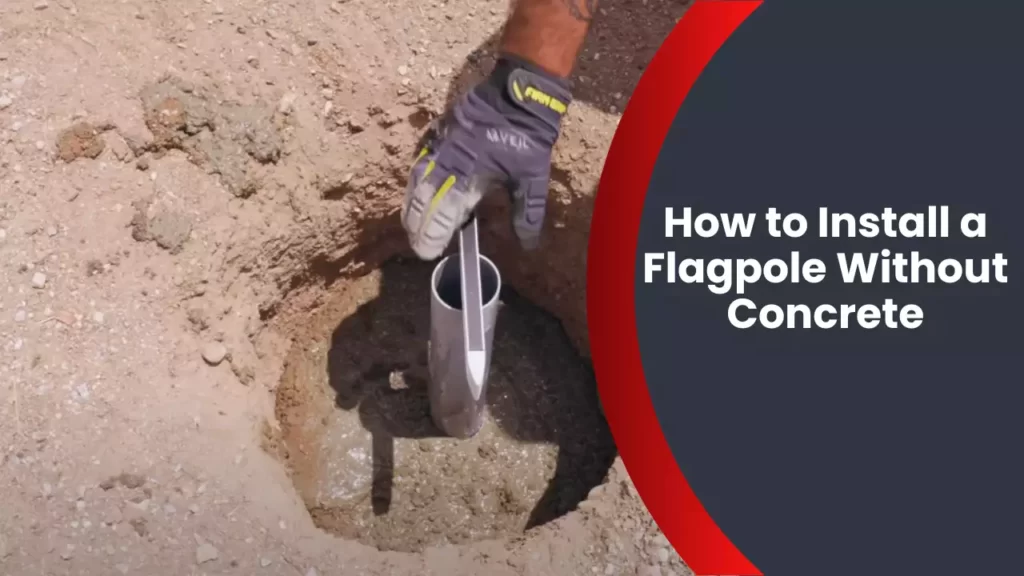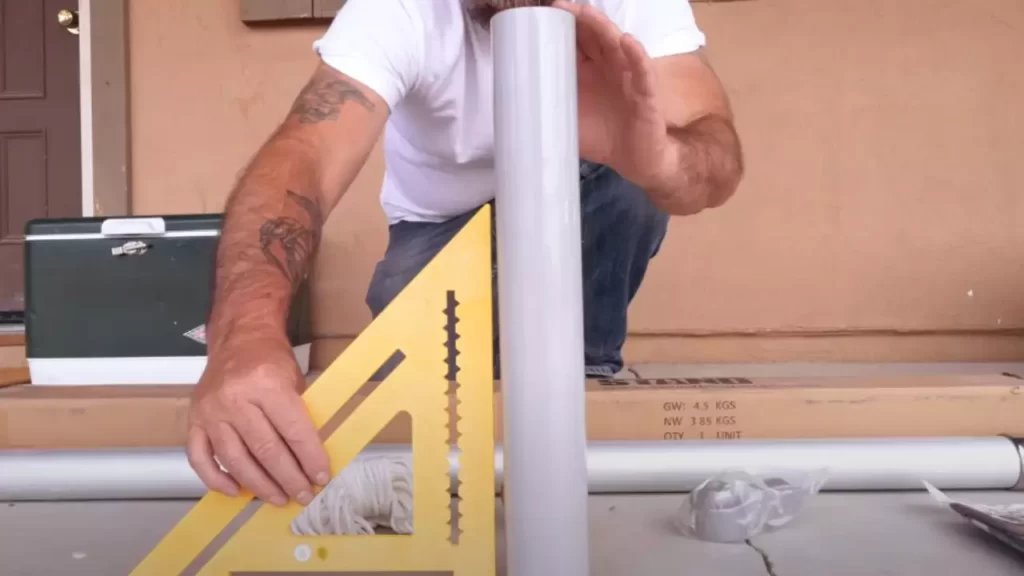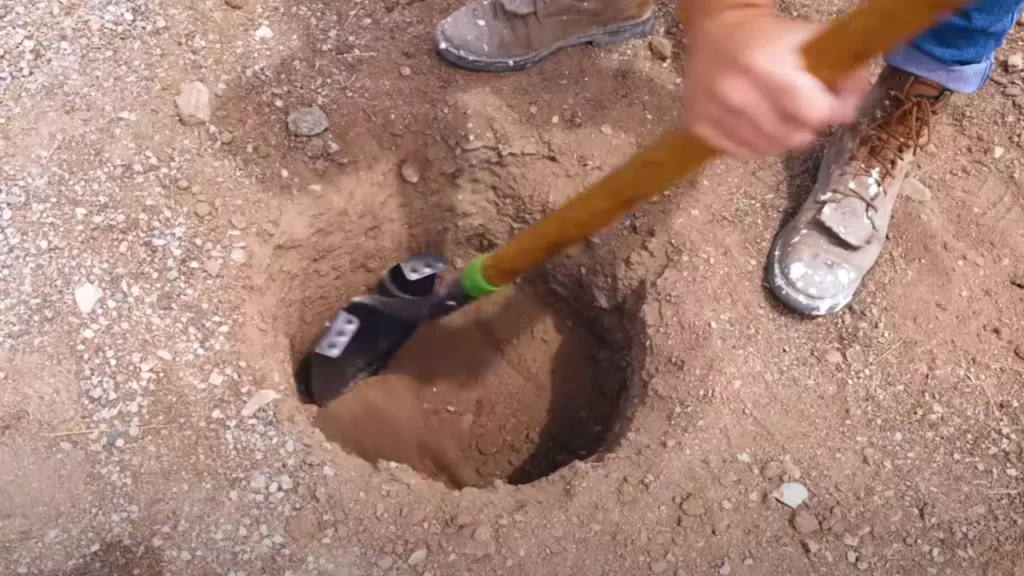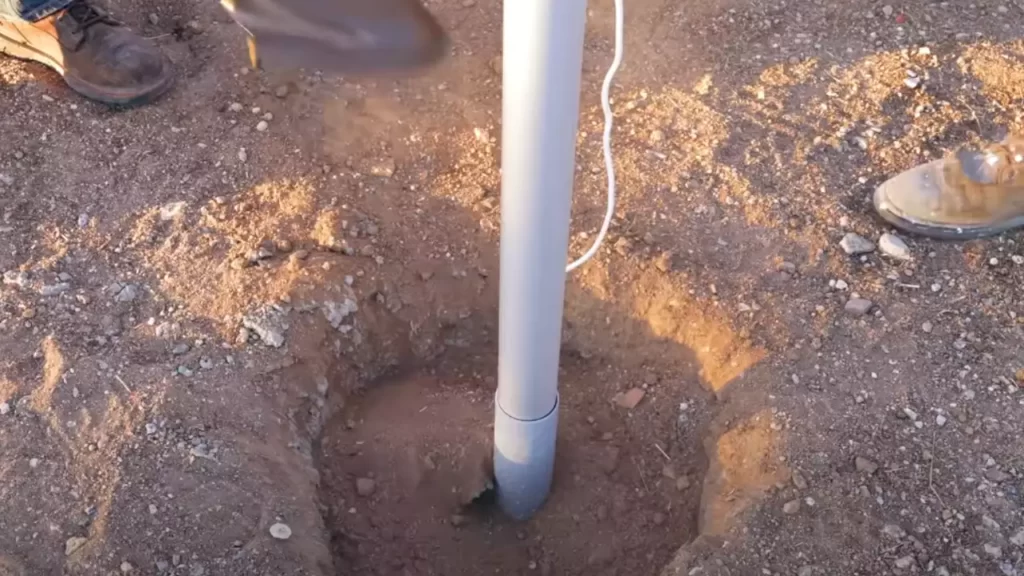To install a flagpole without concrete, you can use a ground sleeve or a mounting bracket. Ground sleeves are buried in the ground and provide stability for the flagpole, while mounting brackets attach the flagpole to a solid structure like a wall or fence.
Both options offer a secure and durable way to install a flagpole without the need for concrete. Ground sleeves and mounting brackets can be purchased at hardware stores or online, and come with instructions for installation. Before installing your flagpole, be sure to check local regulations and requirements for height and placement to ensure compliance.
Preparing The Ground
Before installing a flagpole without concrete, it is important to properly prepare the ground to ensure stability and longevity. This involves choosing the right location, clearing the area of debris and obstacles, and checking for underground utilities.
Choosing the Right Location for Your Flagpole
When selecting a location for your flagpole, it is crucial to consider factors that will contribute to its visibility, safety, and durability. Here are a few tips to help you make the right choice:
- Ensure the location has suitable space for the flagpole and enough clearance to prevent the flag from being obstructed by surrounding structures or trees.
- Avoid placing the flagpole too close to utility lines, buildings, or other tall structures that may interfere with the flag’s movement or compromise the pole’s stability.
- Look for an area with good soil conditions, as the ground needs to be firm enough to hold the flagpole securely without the need for concrete.
Clearing the Area of Debris and Obstacles
Once you have identified the ideal location for your flagpole, it is essential to clear the area of any debris or obstacles that may impede the installation process or pose a risk to the pole’s stability. Follow these steps to prepare the ground:
- Remove any rocks, branches, or other large objects from the area. These items can potentially interfere with the flagpole’s foundation or cause uneven ground.
- Trim any overhanging branches or bushes that could come into contact with the flag or limit its visibility.
- Level the ground using a shovel or rake to ensure a smooth and even surface for the flagpole installation.
Checking for Underground Utilities
Before beginning any digging or ground preparation, it is crucial to check for underground utilities to avoid damaging gas, water, or electrical lines. Follow these steps to ensure the safety of your installation:
- Contact your local utility companies to mark the location of underground utilities in the area where you plan to install the flagpole. This service is typically free but may require advanced notice.
- Wait until the utility lines have been marked before proceeding with any digging or excavation. This will help you avoid potential hazards and ensure the integrity of your flagpole installation.
- Once the area has been marked, carefully avoid the designated areas, ensuring you follow the recommended guidelines provided by the utility companies.
By carefully preparing the ground before installing your flagpole without concrete, you can ensure a secure and aesthetically pleasing display. Remember to choose the right location, clear the area of debris and obstacles, and check for underground utilities to guarantee a successful installation.

Foundation Alternatives To Concrete
Using a Ground Sleeve for Easy Installation
When it comes to installing a flagpole without concrete, one popular option is to use a ground sleeve. A ground sleeve is a cylindrical tube that is set into the ground and serves as a stable foundation for your flagpole.
The process of installing a flagpole with a ground sleeve is relatively simple. First, you’ll need to dig a hole that is deep enough to accommodate the ground sleeve. The diameter of the hole should be slightly wider than the ground sleeve to allow for proper positioning.
Once the hole is dug, you can insert the ground sleeve into the hole and ensure it is level. You can use a spirit level to check that the ground sleeve is perfectly vertical. This step is crucial to ensure that your flagpole stands straight and secure.
After the ground sleeve is in place, you can fill the surrounding area with compacted dirt or gravel. This will provide additional stability to the ground sleeve and prevent it from shifting or becoming unsteady.
Anchoring with Ground Screws or Earth Anchors
If you are looking for an alternative to a ground sleeve, you can consider anchoring your flagpole using ground screws or earth anchors. These options are especially useful if you are dealing with rocky or hard soil conditions.
Ground screws or earth anchors are long, threaded rods that are driven into the ground using a specialized tool. These rods provide a strong and secure foundation for your flagpole.
The installation process for ground screws or earth anchors is fairly straightforward. First, you’ll need to mark the exact location where you want to install your flagpole. Then, using the appropriate tool, drive the ground screw or earth anchor into the ground until it is firmly in place.
It’s important to note that the length and diameter of the ground screw or earth anchor will depend on the height and weight of your flagpole. Therefore, it’s essential to consult the manufacturer’s recommendations to ensure you choose the right size for your installation.
Installing with a Helical Pile System
Another option for installing a flagpole without concrete is to use a helical pile system. The helical pile system consists of long metal shafts with helical plates, which are screwed into the ground to provide a secure foundation.
The installation process for a helical pile system typically involves using a hydraulic torque motor to drive the helical piles into the ground. The piles are screwed into the soil until they reach the desired depth and provide the necessary stability for your flagpole.
One of the advantages of using a helical pile system is that it can be installed in any type of soil, including sandy, clay, and rocky soils. This makes it a versatile and reliable option for installing a flagpole without concrete.
Before installing a flagpole with a helical pile system, it is essential to consult with a professional installer who can assess the soil conditions and determine the appropriate size and configuration of the helical piles for your specific project.

Installing The Flagpole
When it comes to installing a flagpole without concrete, there are several key steps you need to follow to ensure a secure and stable installation. In this guide, we will walk you through the process of installing the flagpole, from assembling the flagpole sections to raising and adjusting it. By following these steps, you can have your flagpole installed in no time, without the need for concrete.
Assembling the Flagpole Sections
The first step in installing a flagpole without concrete is to assemble the flagpole sections. Most flagpoles come in multiple sections that need to be connected together. Here’s how you can do it:
- Begin by unpacking all the flagpole sections and laying them out in the order they are meant to be assembled.
- Apply a small amount of lubricant or wax to the male end of the first section to make it easier to slide into the female end of the next section.
- Align the holes in the sections and insert the provided screws or bolts to secure them together. Use a wrench or screwdriver, depending on the type of fasteners provided.
- Repeat this process for each section until the flagpole is fully assembled.
Securing the Flagpole to the Foundation
Once the flagpole is assembled, the next step is to secure it to the foundation. Follow these steps:
- Determine the location for your flagpole and mark the spots where the anchor bolts will be placed.
- Drill holes into the foundation at the marked spots using a masonry drill bit, making sure the holes are deep enough to accommodate the anchor bolts.
- Insert the anchor bolts into the holes and tighten them using a wrench.
- Place a level on the protruding anchor bolts to ensure they are perfectly vertical.
- Slide the lower section of the flagpole over the anchor bolts, making sure it sits securely on top of them.
- Proceed to tighten the nuts on the anchor bolts to firmly secure the flagpole to the foundation.
Raising and Adjusting the Flagpole
Once the flagpole is secured to the foundation, it’s time to raise and adjust it. Here’s how:
- Enlist the help of a friend or family member to assist you in raising the flagpole.
- Carefully lift the flagpole into an upright position.
- Ensure the flagpole is straight and aligned with the desired orientation.
- Once the flagpole is in position, secure any sections that may have come loose during the raising process.
- Finally, attach the flag to the flagpole using the appropriate flag clips or ties.
Now that you have successfully installed your flagpole without concrete, take a moment to admire your work and enjoy the beauty of your flag proudly waving in the wind.

Tips For Maintenance And Durability
Proper maintenance and durability are crucial for keeping your flagpole in optimal condition. By following a few simple guidelines, you can ensure that your flagpole lasts for years to come. This section provides tips on how to clean and maintain your flagpole, how to protect it against weather and natural elements, and how to check and replace hardware regularly.
Properly Cleaning and Maintaining Your Flagpole
Cleaning your flagpole regularly is essential to prevent the buildup of dirt, grime, and algae, which can deteriorate the surface and affect its overall appearance. To ensure proper cleaning:
- Use a mild dish soap and warm water solution to gently scrub the flagpole with a soft-bristle brush.
- Rinse the flagpole thoroughly with clean water to remove any soap residue.
- Dry the flagpole using a soft cloth or towel to prevent moisture from causing damage.
Additionally, inspect your flagpole regularly for any signs of damage, such as chips, cracks, or fading paint. Addressing these issues promptly can prevent further deterioration and prolong the lifespan of your flagpole.
Protecting Against Weather and Natural Elements
Exposure to harsh weather conditions and natural elements can impact the durability of your flagpole. To protect it:
- Apply a protective coating, such as a clear sealant or wax, to the surface of the flagpole to prevent corrosion and damage from UV rays.
- Consider installing a lightning protection system to safeguard against lightning strikes.
- During severe weather events, such as hurricanes or strong winds, remove the flag to prevent excessive stress on the flagpole.
By taking these precautions, you can help increase the lifespan of your flagpole and ensure it remains in excellent condition throughout the year.
Checking and Replacing Hardware Regularly
The hardware of your flagpole plays a vital role in its stability and overall functionality. To maintain these components:
- Inspect the flagpole’s pulleys, rope, and clips regularly to ensure they are in good working condition.
- Tighten any loose screws or bolts found on the flagpole, ensuring everything is secure.
- Replace any worn-out or damaged hardware promptly to prevent further issues.
Regular inspections and maintenance of the hardware will help avoid accidents like flags getting tangled, ropes breaking, or pulleys malfunctioning.
Following these tips for maintenance and durability will not only keep your flagpole looking great but also ensure its longevity. By dedicating a little time and effort to the upkeep of your flagpole, you can proudly display your flag for years to come.

Enhancing The Appearance Of Your Flagpole
When it comes to displaying your flag with pride, the appearance of your flagpole is just as important as the flag itself. Enhancing the aesthetics of your flagpole not only adds charm and character to your outdoor space, but it also ensures that your flag is showcased in the best possible way. In this section, we will explore some effective ways to enhance the appearance of your flagpole.
Choosing the Right Flag Size and Material
The size and material of your flag play a crucial role in making your flagpole visually appealing. Here are some tips to help you choose the right flag size and material:
- Consider the height of the flagpole: A taller flagpole will require a larger flag to maintain proportion. As a general rule, the length of the flag should be about one-quarter to one-third the height of the flagpole.
- Opt for high-quality materials: Choosing a flag made of durable materials, such as nylon or polyester, ensures longevity and vibrant colors. These materials are also designed to withstand different weather conditions.
- Select appropriate colors: Vibrant and contrasting colors make your flag more visually striking. If you have multiple flags on the same flagpole, ensure they complement each other and don’t clash.
Adding Decorative Accessories and Lighting
Enhance the beauty of your flagpole by adding decorative accessories and lighting. Here are some ideas to consider:
- Flagpole ornaments: Crown your flagpole with a decorative finial or eagle ornament. These small additions can give your flagpole a touch of elegance and personalization.
- Flagpole brackets: Install decorative brackets to hold and display your flag. Choose brackets that match your outdoor decor style and enhance the overall appearance of your flagpole.
- Flagpole lighting: Illuminate your flag during nighttime hours with flagpole lights. LED solar lights are an energy-efficient option that provides a soft and inviting glow.
Displaying Multiple Flags on the Same Flagpole
If you want to display multiple flags on the same flagpole, follow these guidelines to ensure an organized and visually appealing arrangement:
- Choose flags of similar size: To maintain balance and symmetry, select flags that are relatively the same size. This creates a cohesive and visually pleasing display.
- Space the flags evenly: Ensure there is enough space between each flag to allow them to fly freely and avoid tangling. This also gives each flag the opportunity to be seen individually.
- Consider flag compatibility: If you choose to fly flags of different countries or organizations on the same flagpole, be mindful of any potential conflicts or sensitivities. Research flag protocols and guidelines to ensure proper and respectful display.
By implementing these tips and ideas, you can enhance the appearance of your flagpole and showcase your flag with pride. Remember to regularly inspect and maintain your flagpole to ensure it continues to look its best for years to come.
Flagpole Safety And Regulations
Installing a flagpole without concrete offers a convenient and flexible alternative for homeowners looking to proudly display their flags. However, it is important to prioritize safety and adhere to local zoning regulations and HOA guidelines. By following these regulations and implementing proper safety measures, you can ensure a secure and hazard-free installation. In this article, we will explore key aspects of flagpole safety and regulations, including understanding local zoning and HOA guidelines, properly installing safety devices and equipment, and conducting regular inspections and repairs.
Understanding Local Zoning and HOA Guidelines
Before installing a flagpole, it is crucial to familiarize yourself with the specific guidelines and regulations set by your local zoning authority and homeowners association (HOA). These regulations may dictate the height limitations, setback requirements, and other specifications for flagpole installations. Ignoring these guidelines can result in fines or other legal consequences, so it is essential to conduct thorough research and obtain necessary permits before proceeding with the installation.
Properly Installing Safety Devices and Equipment
Ensuring the safety of your flagpole installation involves using appropriate safety devices and equipment. This includes choosing a sturdy and appropriate flagpole material, such as fiberglass or aluminum, as it should be able to withstand wind speeds and adverse weather conditions in your area. Additionally, installing proper ground sleeves or brackets will provide stability and prevent the flagpole from tilting or falling. It is also crucial to secure the flagpole against theft or vandalism by using lockable mechanisms or anti-theft devices.
Conducting Regular Inspections and Repairs
Once the flagpole is installed, it is essential to conduct regular inspections and repairs to ensure its longevity and continued safety. Regularly inspect the flagpole’s structure, including the pole, base, and any supporting devices, for signs of wear, rust, or damage. Address any issues promptly, such as loose bolts or fraying ropes, to prevent accidents or deterioration. Regular inspections will help identify potential hazards and allow for timely repairs, ensuring that your flagpole remains safe and in optimal condition.
By understanding and following local zoning and HOA guidelines, properly installing safety devices and equipment, and conducting regular inspections and repairs, you can enjoy the beauty of your flag display while maintaining a safe environment for yourself and others. Prioritizing flagpole safety not only ensures compliance with regulations but also guarantees the longevity and integrity of your flagpole installation.
Frequently Asked Questions
Do Flag Poles Need Concrete?
Flag poles typically require concrete for stability and security. Concrete provides a solid foundation that prevents the pole from falling or swaying in strong winds. Without concrete, flag poles may become unstable and pose potential safety risks.
How Deep Does A Flagpole Need To Be In The Ground?
A flagpole needs to be buried underground at a depth of around 10% of its total height for stability.
How Do You Install A Flagpole In The Ground?
To install a flagpole in the ground, start by digging a hole according to the manufacturer’s instructions. Insert the flagpole into the hole, making sure it is level. Fill the hole with concrete, and let it dry completely. Attach the flag to the pole, and you’re all set!
What Holds A Flagpole In The Ground?
A flagpole is held in the ground using a ground sleeve or an anchor. The ground sleeve is a tube-like structure that is inserted into the ground, providing support for the flagpole. The anchor is a metal device that is buried in the ground and attached to the flagpole, keeping it secure.
Conclusion
Installing a flagpole without concrete is a feasible option for those who want to showcase their patriotism or add a touch of elegance to their surroundings. By following the steps outlined in this guide, you can successfully secure your flagpole using alternative methods such as ground sleeves or anchor systems.
Whether you’re concerned about the environmental impact, aesthetics, or convenience, these alternative installation methods offer a practical solution. So go ahead and proudly fly your flag without the need for concrete!
